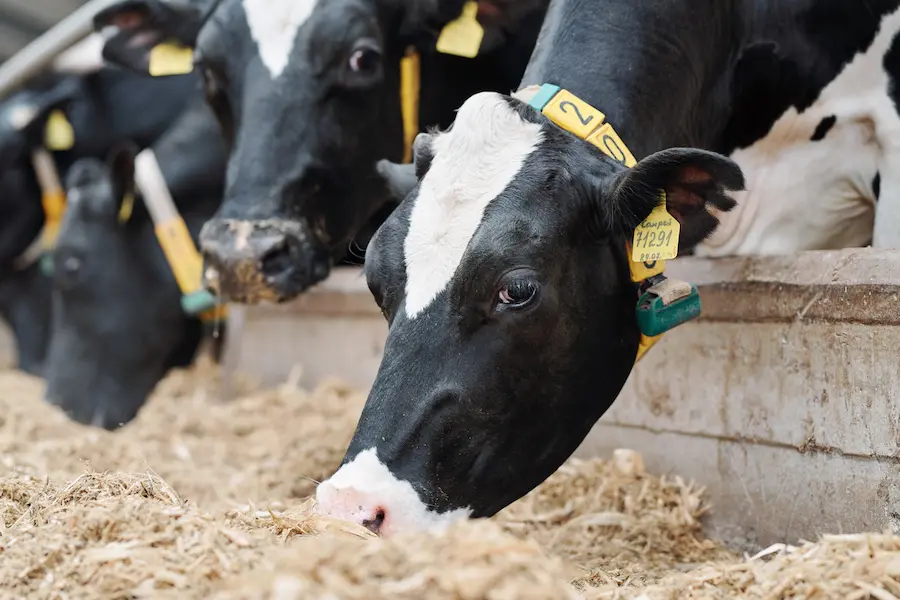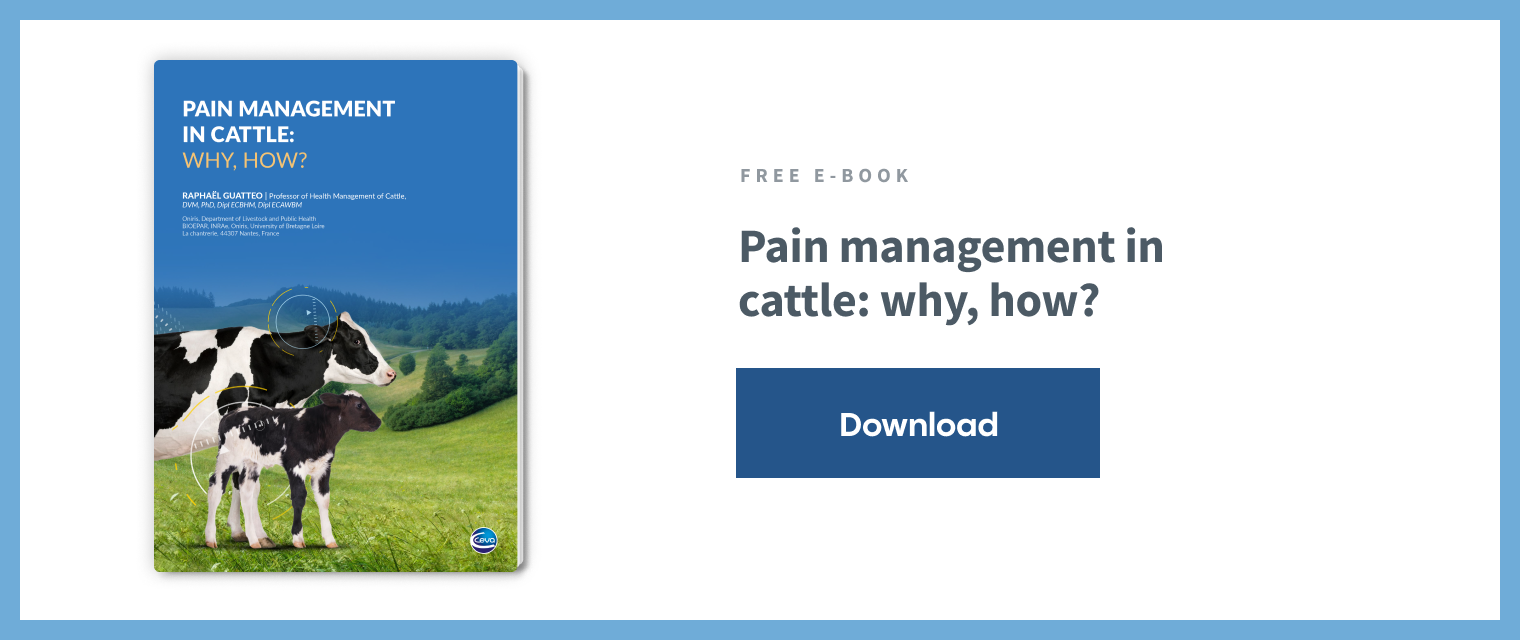Before the 1960s, most dairy cow herds were housed in barns and fed concentrates placed on forage. Therefore, cow feed primarily consisted of roughage, being hay or silage in the colder months and pastures in the warmer seasons, when available, in most cases.
At this time, concentrates typically contained locally available grains such as corn, oats, wheat, barley and a protein source such as soybean meal, cottonseed meal and linseed meal. The need for vitamins and minerals received little or no attention.
Cow feed evolution: from traditional methods to TMR
Initially, part of the concentrate was offered in the milking parlor, as an incentive to take the cows to the milking parlor, but this represented a serious problem: the fodder was fed separately from the concentrates, which often led to digestive disorders, e.g. changes in ruminal pH. Dairy farmers also realized that cows did not have enough time in the milking parlor to consume the amount of concentrate needed and that milking times were faster and cleaner without concentrate feed in the parlor.
Dairy production is an essential part of the agricultural industry, providing milk and its derivatives for human consumption.
To ensure that dairy cows consistently produce more high-quality milk, it is essential to provide them with an adequate and balanced diet.
One of the most effective approaches to achieving this goal is the use of Total Mixed Ration (TMR).[1]
What does TMR consist of?
TMR is a feeding strategy that involves the precise mixing of various feed ingredients such as forages, concentrates and other feed ingredients into a single balanced diet for dairy cows, meaning a complete compost feed. The mixture is made homogeneously, in a TMR unit, that consist basically of a giant mixer, to ensure that each portion of feed contains all the essential nutrients necessary to maintain the cows' health and milk production .
One of the objectives of the daily ration is to ensure that consumption is optimized, and that feed is consumed homogeneously. To optimize dry matter consumption, it is desirable to work towards an optimal range of ruminal pH, avoiding high fluctuations. A diet rich in forage provides a higher ruminal pH and better consumption conditions.[2] By providing fiber ingredients together with concentrate feeds in a total mixed ration diet, pH fluctuations are minimized.
TMR is a very controlled approach, where the quality and quantity of each ingredient is monitored to meet the specific nutritional needs of the animals. This is essential to ensure consistent performance of dairy cows over time.
Therefore, mixed ration, also known as TMR, is a mixture of concentrated and roughage feeds, balanced according to the nutritional needs of dairy cows, and given to the animal throughout the day.[3]

Total Mixed Ration Composition (TMR)
The composition of the mixed ration varies depending on the cow's production stage, its age and its health condition. Normally, the mixed feed consists of concentrated and roughage feeds.[4]
Concentrated feeds are sources of energy, protein, minerals and vitamins. The main concentrate feeds used in TMR for dairy cows are:
- Corn: is the main source of energy in the mixed ration
- Soybean meal: it is a source of high quality protein
- Oilseed pomace: it is also a source of high quality protein
- Wheat bran: is a medium source of protein
- Soy hulls: it is a source of fiber
- Rice bran: it is also a source of fiber
- Urea: is a source of non-protein nitrogen, which can be used to increase the protein content of the feed
Bulky feeds are sources of fiber and energy and the main ones used in TMR for dairy cows are:
- Corn silage: it is the main source of fiber in mixed rations
- Green feed: it is a source of energy and fiber
- Hay: is a source of fiber
- Sugar cane: it is a source of energy
Regarding the formulation of the mixed ration, it is important to consider that this must be carried out by an animal nutritionist, who will consider the nutritional needs of dairy cows, the cost of feed and its availability. The quality of the ingredients used in TMR is fundamental, meaning it is important to invest in high-quality ingredients.
The preparation of mixed feed must be done carefully to prevent feed from mixing unevenly. To achieve this, the TMR can be prepared manually, which takes a lot of time to handle, or with the help of proprietary equipment such as vertical or horizontal mixers.
Once prepared, the mixed feed must be stored in a cool, dry place to prevent feed spoilage. TMR must be fed to cows at regular times and in sufficient quantities to meet nutritional needs.
Advantages and Disadvantages of TMR[1], [5], [6]
Advantages of TMR
- Nutritional homogeneity: one of the biggest advantages of TMR is the ability to provide uniform nutrition for all cows. This helps prevent competition for feed, ensuring each cow receives the nutrients needed for consistent milk production.
- Improved feeding efficiency: with TMR, less time is spent with feeding cows, since the feed is prepared in advance, which saves labor that can be applied to other tasks. As the mixed ration is formulated to meet the nutritional needs of cows, this results in better use of nutrients and consequently increases productivity.
- Precise Nutritional Control: TMR allows precise control of nutrients, which is vital to meet the specific needs of each cow at different stages of lactation, allowing to optimize milk production, weight gain and overall cow health.
- Waste reduction: as in TMR, all ingredients are mixed homogeneously, there is no waste, for example when the cow selects only the components of her preference.
- Improves milk quality: a balanced and homogeneous diet, such as mixed feed, allows to obtain milk with higher levels of fat and protein.
- The incidence of digestive and metabolic problems often decreases when a TMR is fed, and milk production has been shown to be up to 5% higher with a TMR compared to conventional feeds due to these benefits.
- One of the main advantages of mixing all foods in a TMR is that it can mask the flavor of less palatable foods. Foods such as urea, limestone, fats and some secondary protein sources may be less palatable. However, through mixing, they can be added to the TMR in reasonable amounts, with little or no reduction in feed consumption.

Disadvantages of TMR
- Cost: mixed feed is more expensive than feeding separate concentrated and roughage foods. Mixer wagons are expensive.
- Complexity: TMR formulation and preparation is complex and requires the support of an animal nutritionist.
Conclusion
Using TMR to feed dairy cows is a highly effective strategy to ensure consistent milk production, improve milk quality and optimize efficiency in the dairy operation.
However, it must be considered that its implementation requires careful planning, constant monitoring and attention to the quality of the ingredients used. Thus, it can be said that TMR can be a valuable tool for dairy producers looking to maximize the performance of their animals.
References
[1] D. J. Schingoethe, “Uma revisão de 100 anos: alimentação com ração mista total para vacas leiteiras,” Elsevier, Dec. 2017, Accessed: Sep. 21, 2023. [Online]. Available: https://www.sciencedirect.com/science/article/pii/S0022030217310445
[2] “Quais as vantagens de utilizar Ração Total Misturada (TMR)?,” Milkpoint, May 08, 2018. https://www.milkpoint.com.br/colunas/educapoint/quais-as-vantagens-de-utilizar-racao-total-misturada-tmr-208062/ (accessed Sep. 22, 2023).
[3] J. R. Alves Pereira, “A importância do uso da “Ração Total Misturada,” Canal do leite, Oct. 07, 2020. https://canaldoleite.com/colunas/joao-ricardo-alves-pereira/a-importancia-do-uso-da-racao-total-misturada-tmr/ (accessed Sep. 21, 2023).
[4] “Alimentos concentrados e volumosos: você sabe a diferença?,” Educapoint, Apr. 30, 2021. https://www.educapoint.com.br/blog/pecuaria-geral/alimentos-volumosos-concentrados-diferenca/ (accessed Sep. 21, 2023).
[5] “Rações Mistas Totais para Vacas Leiteiras,” Penn State Extension, Sep. 14, 2023. Accessed: Sep. 21, 2023. [Online]. Available: https://extension.psu.edu/total-mixed-rations-for-dairy-cows
[6] D. Junges, “Silagem de ração em mistura total: uma alternativa que pode ser utilizada na alimentação de ruminantes,” Jun. 13, 2018. https://agroceresmultimix.com.br/blog/silagem-de-racao-em-mistura-total-uma-alternativa-que-pode-ser-utilizada-na-alimentacao-de-ruminantes/ (accessed Sep. 21, 2023).
About the author
Ana Vanessa Dias Sousa (Researcher FeedInov CoLAB)
With a degree in Veterinary Sciences from the University of Trás-os-Montes and Alto Douro, she worked for five years as a field veterinarian and in a pig and cattle feed factory. She worked in the pharmaceutical industry as a sales manager and technical support for pigs, cattle, rabbits and poultry in mainland Portugal and the Azores. She is currently at Feedinov Colab as a Researcher in the One Health Department.
Explore author’s articles



Leave your comments here